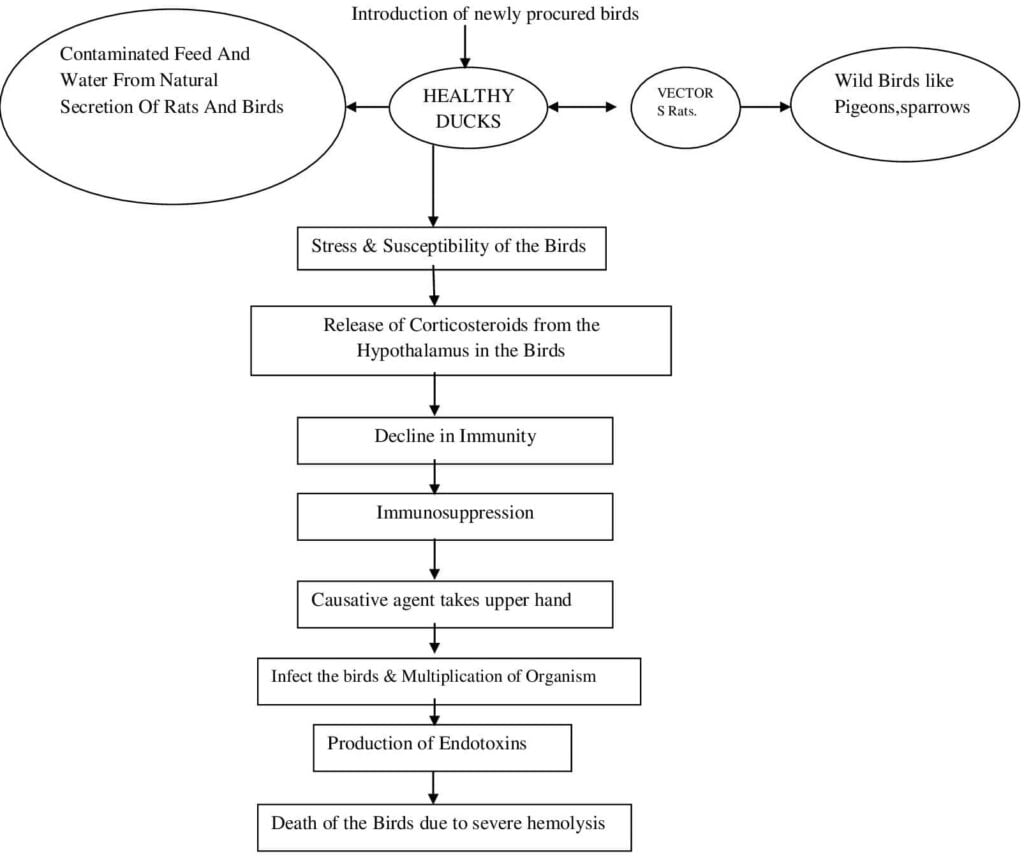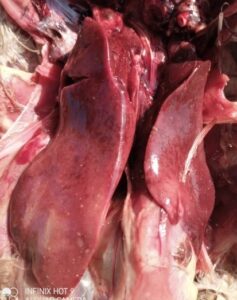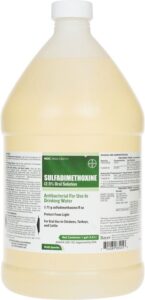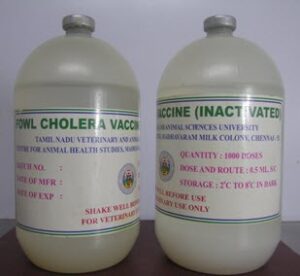Duck Cholera-a disease of economic importance.
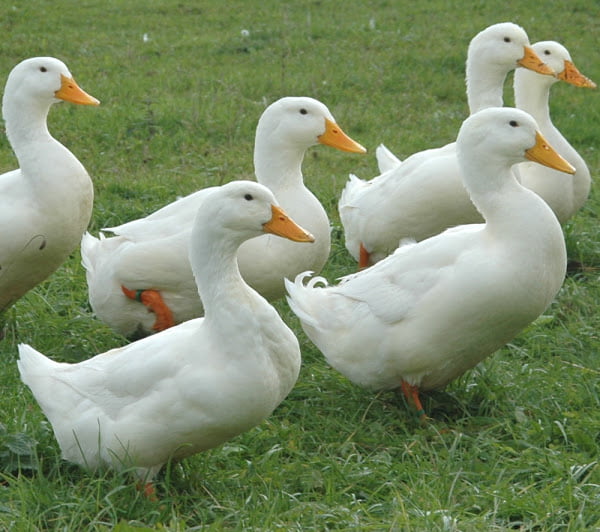
1Dr.Abhijeet Kumar, 2 Dr.P.S Mahesh ,3 Dr.S.M Anwar Basha, 4 Dr.S B Pasanna CPDO&TI-Central poultry Development Organization and Training Institute, Bangalore-560088(1 Farm Manager, 2 Joint Commissioner & Director , 3 Technical Assistant & 4 Associate Professor & Head, Dept. of LPM, VCH, Bengaluru)

Introduction
The word duck in genetic sense belongs to the family Anatidae and can be distinguished from other group by their phenotypical features that includes ducks which are in small in size, short neck, flatter body, short legs and broader bill. Most of the ducks which are domesticated now a day belongs to the descendents of Wild Mallard.
Among Poultry, Duck occupies an important position next to chicken in the world. They are reared for both meat and egg. In India 65% population is depend on agriculture and ailed activities. However the contribution of this sector to the gross domestic product is 16.5 %( Economic survey 2019-20).Although India is self sufficient in food production. It is yet to attain nutritional security. This can be overcome by augmenting the production of protein rich animal products like milk, egg and meat. Duck Farming are potential income generating activities in rural areas which can improve the economic status of the rural people.
Although it is more economical to raise ducks either for eggs and meat purpose but due to spread of disease in large group of flock in short span of time named as duck cholera which is not only affecting the socio economic status of the livestock farmer but also de-motivating the beginners who wants to become a duck entrepreneur. Spread of this type of diseases in the larger flock causes severe losses to the farming community and closing down of the small scale livestock industries. Hence this is high time for the livestock owner to be aware of the prevalence and spread of this disease. This article provides the important practical information about the occurrence &spread of the bacteria in field condition.
Etiology:
Duck Pasteurellosis or Duck cholera is caused by a bacterium known as Pasteurella multocida.It is Gram Negative, cocobacillus, non-motile, non spore forming occurring singly in pairs and rarely in chains. It can grow both aerobically and anaerobically.It produces a toxin known as endotoxin.
The peculiar feature of this organism when a newly isolated strains or organisms in tissues stained with methylene blue or leishman’s stain the bipolar shaped organism appear on examination in the microscope unlike the sample taken on cultivation in agar or broth. Hence to appreciate the Bipolarity (Condensation of chromatin material) in Pasteurella bacterium it is always advisable to take sample directly from affected portion and undergo staining procedure. The pathogenecity of Pasteurella multocida is complex and variable depending on strain, host, species and mode of infection. The organism is highly labile and can be easily destroyed by the common disinfectants.
Transmission of the causative agent:-
Clinical Signs:
The classical symptoms of the duck cholera are based on acute stage and chronic stage of the disease. In acute cases, fever, loss of appetite (anorexia), ruffled feathers, mucous discharges from mouth fetid or greenish diarrohoea and sudden death. And chronic cases when the ducks are recovered from acute form or from infection with an organism of relatively low pathogenecity, the symptom shown are depression, conjunctivitis, dyspnoea, lameness, torticolis and swelling of the eyes. Mortality rate is moderate to high if untreated,death may occur after many days to months.
Gross Lesions
- Epicardial haemorrhages in Heart. Characteristic haemorrhages in sub-pericardial (Peri-carditis) & sub-serosal regions including lungs, abdominal fat and intestinal mucosa.(Fig.1)
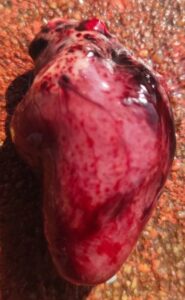
- Hyperemia of the abdominal viscera including duodenal mucosa.(Fig 2)
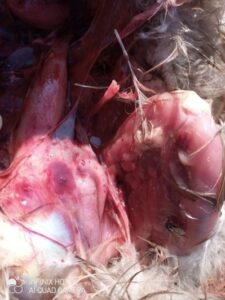
Fig 3.Enlarged liver with White Necrotic foci
- The affected liver will be enlarged with white necrotic foci.(Fig 3)
- Spleen enlargement in affected birds
- Peritonitis, Pericarditis.
- Hemorrhagic enteritis
- In Laying Ducks ovary is commonly affected including hyperemia of immature follicles.
Diagnosis:
- By Pathognomic lesion i.e. epicardial hemorrhages
- Bipolar staining-Bipolar organisms can be demonstrated by microscopical examination of smears from heart blood, cut surfaces of liver, spleen and lung which are stained with leishmans stain or methylene blue.
- A positive diagnosis is made by isolating Pasteurella multocida from bone marrow in appropriate media.
- Inoculation of clinical sample collected from the affected birds into laboratory animals such as rabbit, mice, and birds for identifying the causative strain.
Treatment:
Duck Cholera is a bacterial disease, the use of suitable antibiotics can be treated based on the results obtained from ABST (Antibiotic sensitivity test). Antibiotics like third generation cephalosporins like ceftriaxone@50-100mg/kg body wt for 5 days s/c or I/m with supportive therapy includes vitamin k 25gms/1000 birds. Dilution can be made by mixing 3g vial of Ceftriaxone in 50 ml Multivitamin injection in 100 ml of Normal saline. Dose of the mixed solution is 2ml s/c for 3-5days. Alternatively treatment can be done by using of sulpha drug(Fig 4.) in water. Dilution can be achieved by mixing 100 gms sulpha powder in 100 liters of water for 3days followed by 2 days only plain water. And last two days 50 gms sulpha in 100 litres of water.
Fig 4: Sulfadimethoxine 12.5% Oral Solution
Recontamination should be prevented by providing fresh water always and there should be no common pool of water for ducks since transmission can occur more by faecoral route which again cause reinfection and causing disease.
Prevention and control:
By Vaccination:
Fig 5: Inactivated Fowl cholera Killed Vaccine (TANUVAS)
1) By vaccinating the flock with Killed Duck pasteurella alum precipitated vaccine (Fig 5). Vaccination can be achieved by injecting 2 ml s/c each duck followed by booster dose after 10 days of the primary dose. Since the duck are poor natural immune responder it is always advisable using of immunomodulator like interferon, levamisole and Tulsi leaves (250gms in water).
Practically it is very difficult to achieve the successful vaccination because antibody titer is low due to mixed antigen. So care should be taken while collecting the sample. Usage of autovaccine responds good antibody titre compare to other source of vaccine.
2) Separation of diseased birds by clinical signs from healthy flock.
3) If any history of disease outbreak, clean and disinfect the building and equipment. Disinfection can be following steps:
- Clean all the debris from Duck shed by brooms, spade etc.Ensure debris should be removed completely since debris will reduce the efficacy of disinfectant.
- Through pressure washer wash full shed with the use of detergent. Detergent will soften the hard and sticky debris.
- Use flame gun either kerosene or LPG for entire shed and priority given on top and corner of the shed. Contact time for flame gun in each point is minimum 3-5sec.
- Choice of Disinfectant preferably Quaternary ammonium compounds with gluteraldehyde preparation can be sprayed in entire shed and rest for 3 days.
- Lime washing with disinfectant in floor and walls of the shed.
- Last step fumigation by 3x conc./ 100cubic feet.
4) Routine monitoring of the flocks for health status.
5) Proper litter management.
6) Proper disposal of dead birds.
7) Education and awareness among the farming community about prevalence of the disease and control measures to be taken for prevention of the disease.
Reference:
JADHAV, N.V. AND SIDDIQUI, M.F., 2010. Handbook of poultry production and management. 2 th Edici. Jaypee B, editor.
RANA, M., HOSSAIN, M.T., ISLAM, M.A., RAHMAN, M.M., ALAM, M.K. AND DUTTA, U.K., 2010. Comparative immunogenicity study in ducks of different breeds available at coastal regions of Bangladesh against duck plague and duck cholera vaccines. International Journal of Biological Research, 2, pp.23-27.
SONAIYA, E.B. AND SWAN, S.E.J., 2007. Small scale poultry production: technical guide (Vol. 1). Daya Books.
VEGAD, J.L., 2008. Poultry diseases: a guide for farmers and poultry professionals. IBDC Publishers.
WALLER, L.J. AND UNDERHILL, L.G., 2007. Management of avian cholera Pasteurella multocida outbreaks on Dyer Island, South Africa, 2002–2005. African Journal of Marine Science, 29(1), pp.105-111.

